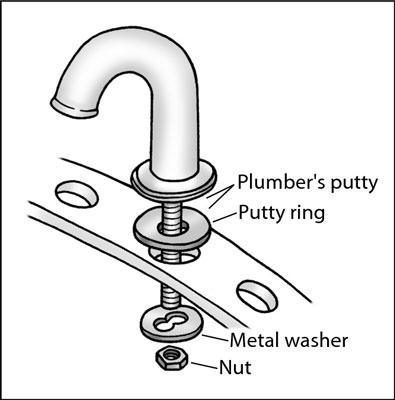If “replace kitchen faucet” is on your to-do list, it may be comforting to know that changing or installing a new faucet is a fairly simple home improvement task. It does, however, usually require temporarily contorting your body into a pretzel-like shape under the sink.
If you can avoid needing to be hoisted out from under the cabinet and being put into traction (we recommend stretching first), this type of project should take less than an hour.
Getting Started
Before you install a kitchen faucet, take a look at the sink. All sinks consist of the same basic parts:
If replacing a faucet requires removing an existing faucet, it’s helpful to assess the situation before you start. If the sink and faucet are old or rusted, it may take more time and tools to remove it. (We always like to keep a sledgehammer nearby. You know, just in case!)
Most faucets are attached to the sink by a plastic nut—or, on older models, a metal one. There are also faucets that mount with bolts on the top, but more than likely you will need to wedge yourself inside the cabinet under the sink to accomplish this fix.
To remove an old faucet, shut the water off at the pipes under the sink or at the main shutoff to the house. Then remove the water connections and the nuts securing the faucet to the sink.
Tools & Materials We are a participant in the Amazon Services LLC Associates Program, an affiliate advertising program designed to provide a means for us to earn fees by linking to Amazon.com and affiliated sites.Installing a Faucet in 3 Simple Steps
STEP 1: Install the sink gasket.
Before a new faucet is attached, a seal is needed between the faucet and the sink. Some new faucets come with a plastic or rubber gasket. If not, you can make a snake from plumber’s putty and put it on the sink where the faucet will sit. If you’re wondering how to use plumber’s putty, you’ll find that it’s similar to working with Play-Doh.

STEP 2: Position the faucet in the holes.
Attaching the faucet to the sink is pretty easy. After the gasket or putty is in place, set the faucet into the proper holes. Position yourself under the sink, and screw on the plastic nut. If you’ve used plumber’s putty you can clear away the excess with a putty knife or use a finger.
STEP 3: Connect the faucet to the water lines.
Some faucets (Delta Faucet brand, for example) come with flexible PEX lines connected to the faucet already, which makes this step much easier as the hoses just need to be connected down at the water lines.
For faucets without lines attached, flexible piping will need to be attached at your line and then to the faucet.First, wrap a bit of Teflon tape around the threads to give everything a tight seal, and then attach the tubing to the new faucet and water line.
If the water lines are behind the sink basin near the top of the cabinet, it can be well worth your while to use a basin wrench instead of struggling through the project with a regular wrench. (We used a regular wrench and it works, but there’s always the chance that your fingers will go numb and you’ll drop a wrench on your head. Not that we would know firsthand…)
Once this step is complete you can turn the water back on, check for any faucet leaks, and enjoy having running water from a new faucet in your sink.
Kit Stansley
Final Thoughts
Replacing a faucet is a fairly easy DIY project that can take about an hour to complete. In order to make sure it doesn’t end up taking a lot longer, it’s important to make sure the new faucet requires the same number of mounting holes and that all the supplies that aren’t included with the new faucet are on hand when beginning the installation.
FAQs About Faucet Installation
While installing a new faucet is a straightforward home improvement project, there are real-life variables that can create questions about the process. To help make this project easier, we’ve answered some of the most common questions about how to install a faucet.
Q. How much does it cost to replace a faucet?
The cost of replacing a faucet depends on a few factors. If you are replacing a faucet and using a budget faucet, it can cost as little as $100. If hiring a plumber to replace a faucet, it can cost an average of $250 or more.
Q. How do you use plumber’s putty?
Plumber’s putty is similar to Play-Doh. The first step is warming up the putty in your hands until it is soft. Then stretch and roll the putty into a long snake-like form. Spread the putty around the clean and dry surface. Lastly, press it into place.
Q. How long should a sink faucet last?
The longevity of a faucet depends on many factors, including the design, material, and the type of water running through it. Homes with hard water are tougher on all plumbing, including faucets. However, in general, a faucet can be expected to last about 15 years or more.
Q. Can you put a one-hole faucet in a three-hole sink?
Yes, you can replace a three-hole faucet with a one-hole faucet. To cover the extra holes, use a deck plate, which is also called an escutcheon plate.
Q. How does a single-hole faucet work?
Single-hole faucets have both hot and cold water combined in the faucet. When the faucet is turned on, there is an interior valve that releases the needed amount of hot or cold water.
